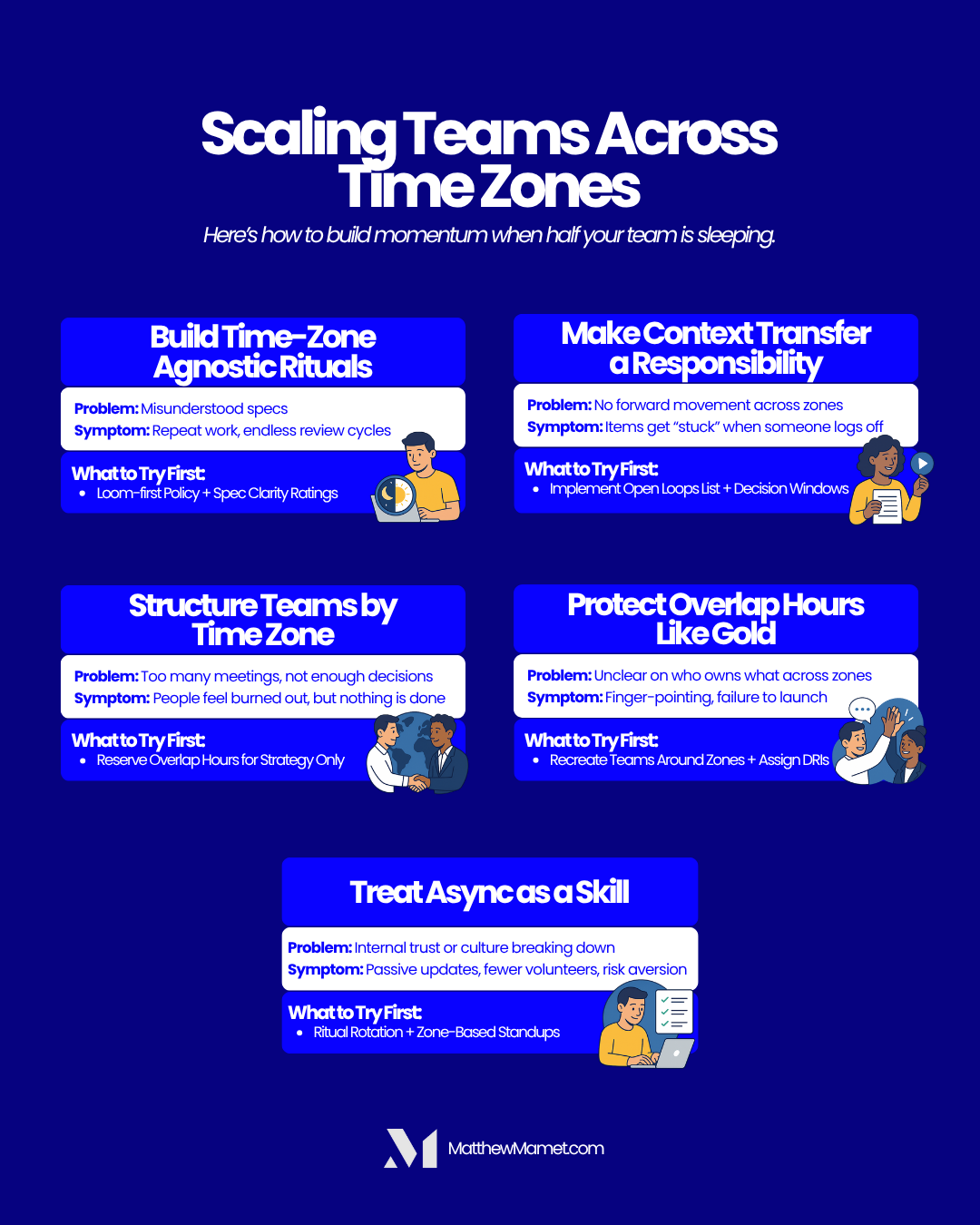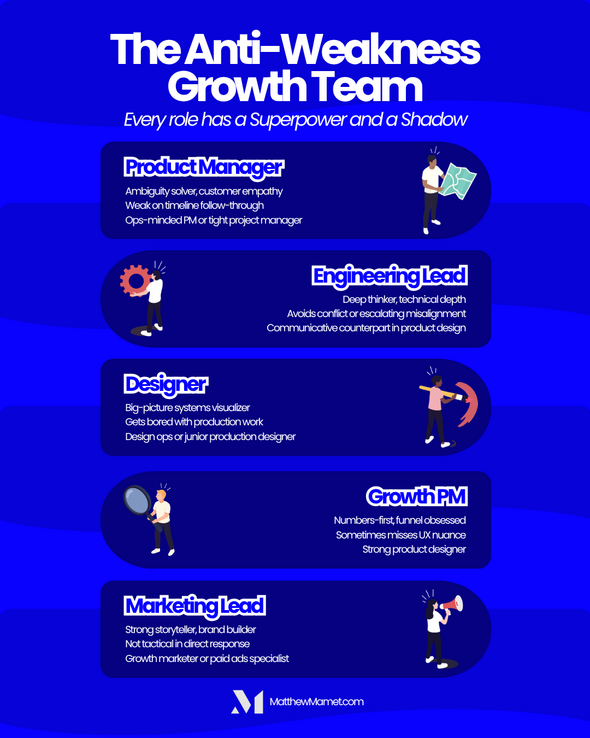Death by Asynchronous Updates
We were building a new monetization layer for a fast-scaling marketplace. The dev team was split - Vietnam, London, and New York. Every standup felt like Groundhog Day. Product specs sat misinterpreted. Feedback landed after sprint cycles closed. Deadlines slipped while everyone waited for responses that came nine hours too late. The kicker? Everyone was trying hard. It just wasn’t working.
Distributed product teams sound efficient in theory - follow-the-sun, 24/7 velocity, yada yada. But that fantasy ignores the real trade-off: coordination complexity.
Here’s what no one admits up front - if you don’t fix your rituals, information flow, and culture of ownership by time zone, “scaling product management” just means more fire drills in Slack at 2 a.m.
Let’s break this down and fix it.
Build Time-Zone Agnostic Product Rituals
Start here: if your core product rhythm depends on people being online at the same time, it will break.
Most teams try to accommodate time zones with an extra weekly standup or a shared Notion doc. That’s duct tape. You need deeper change.
- Assign “ritual owners” in each location. Don’t expect people to just adopt strong process - give someone the job. One timezone drives product brief fidelity. Another owns async sprint kickoffs. Rotate roles monthly. This gives everyone a sense of ownership - without forcing 11 p.m. Zooms.
- Document religiously. Every idea needs a place. Decisions need a timestamp. Context should be written down as clearly as specs. If you don’t already have one, build a product operating system using a shared tool like Notion, Linear, or Almanac. Otherwise, rituals become the first casualty of time difference.
- Create “decision windows”, not meetings. Instead of booking a meeting, define a window for team input (“This needs cross-functional feedback by 2pm UTC Friday”). This improves inclusivity - people in Mumbai and Toronto can participate equally - and forces tighter, clearer communication.
Ready to drive more growth & achieve bigger impact?
Leverage my 25+ years of successes and failures to unlock your growth and achieve results you never thought possible.
Get StartedMake Context Transfer a First-Class Responsibility
Here’s the real killer of momentum in remote product work: misunderstood context.
It’s not that people drop balls. It’s that they pick up the wrong one and run a mile with it before getting corrected.
To fix that, you need repeatable habits for context transfer. At Tripadvisor, we scaled from a single team to dozens across Europe and the U.S. What kept things tight: our “Open Loops” list. Before ending their day, each PM dropped a line on what was still unresolved - assumptions they were testing, questions to answer, decisions hanging. That single behavior created continuity from timezone to timezone.
Another winner? “Loom first, then spec.” If a spec couldn’t be explained clearly in a 3-minute Loom, it wasn’t ready to ship. Screenshots, use cases, clear trade-offs - all spoken aloud. Way better than a 10-page doc emailed to an engineer in Bucharest who’s never met the PM.
Pair this with strong decision logging. Have a “decisions made” Slack channel - or better yet, use your stand-up notes to clearly tag what's decided, what changed, and who needs to know.
You don’t want your team asking: “Wait, who decided this?” at 7 a.m. before their coffee hits.
Structure Teams Around Time Zones, Not Just Function
This one sounds obvious but is almost always ignored.
If you split teams by function (PMs here, designers there, engineers over there), you spend half your energy syncing instead of shipping.
Whenever possible, set up squads within a logical zone overlap. Example: PM in Toronto, design in Argentina, dev in São Paulo - that time block works. Alternatively, group product, design, and engineering within three hours of each other, then appoint one timezone as “core hours”.
Also, minimize cross-timezone handoffs by defining ownership clearly. If two PMs share a product area and sit across oceans, pick one as the DRI for execution, the other for strategic inputs. Overlap creates friction, not magic.
Bonus tip: don’t make people manage up across time zones. Exec check-ins should happen in the PM’s time zone, not vice versa. It’s a massive credibility boost - and performance unlock - and avoids burnout masked as grit.
Ready to drive more growth & achieve bigger impact?
Leverage my 25+ years of successes and failures to unlock your growth and achieve results you never thought possible.
Get StartedPrioritize Overlap Hours Like Prime Real Estate
You probably only have two or three golden hours a day where everyone is awake. Treat them like your last clean socks on a camping trip - use them wisely.
What that means practically:
- Only do real-time meetings in overlap hours.
- Save 1:1s and lightweight check-ins for async (use tools like tl;dv, Loom, or Fellow).
- Reserve overlapping hours for problem-solving or strategic debate - stuff that can’t be done well async.
- Use calendar visibility (with working hours displayed) to plan better. Map out ideal hours across the team and protect them as no-flight zones for random pings.
One pro move: design a "Zone of Truth" calendar - highlighted overlap time in all team members’ views using a shared color. Helps people visually see when collaboration is expected versus optional.
If it’s always a guessing game when someone will respond, trust erodes. People stop waiting and just ship half-informed.
Treat Asynchronous Work as a Skill, Not a Setting
The assumption that people “should just get good at async” is like saying someone should know how to cook with a fridge full of condiments and no recipe.
Teach it. Practice it. Reward it.
Here’s how:
- Run async retrospectives. Post the board, tag people, give a full business day for input. Discuss trends next sync.
- Score artifacts on clarity. Rate that Loom, spec, Jira ticket, or Miro flow: did it enable understanding without further calls? Make clarity a badge of honor.
- Celebrate delayed response culture. Someone asks a question at 10pm your time? Great - answer it in the morning, with clarity, context, and a link. Don’t reward speed over substance.
The best PMs in multi-timezone orgs aren’t the fastest - they’re the clearest, most structured communicators. It’s not about Slack volume. It’s about Slack velocity with purpose.
For more on structure that scales well, especially in fast-changing product orgs, I’ve written about how to build a framework for growth and product team structures worth copying.
Ready to drive more growth & achieve bigger impact?
Leverage my 25+ years of successes and failures to unlock your growth and achieve results you never thought possible.
Get StartedWhat It Looks Like in Practice
In coaching execs or shipping product, here’s how these shifts show up:
- A Berlin-based product lead redesigns her sprint planning - not with more meetings, but by turning Monday check-ins into recorded “narrated” backlogs. Engineers love it. Specs click faster.
- A startup CEO with teams in Tel Aviv and San Francisco uses “decision deadlines” instead of meetings. That subtle shift decreased stalls by 30% in Q2.
- A US PM working with a Bangladeshi QA team creates a video series walking through bugs - not just text notes. Escapes the “can’t reproduce” loop. Productivity ticks up, and burnout down.
- One founder built what he called an “async bullpen” - four hours blocked weekly where his core team writes, updates, and hands off product decisions between time zones. Messy became manageable.
Here’s a cheat-sheet to help pick your focus area:
| Problem | Symptom | What To Try First |
|---|---|---|
| Misunderstood specs | Repeat work, endless review cycles | Loom-first Policy + Spec Clarity Ratings |
| No forward movement across zones | Items get “stuck” when someone logs off | Implement Open Loops List + Decision Windows |
| Too many meetings, not enough decisions | People feel burned out, but nothing is done | Reserve Overlap Hours for Strategy Only |
| People unclear on who owns what across zones | Finger-pointing, failure to launch | Recreate Teams Around Zones + Assign DRIs |
| Internal trust or culture breaking down | Passive updates, fewer volunteers, risk aversion | Ritual Rotation + Zone-Based Standups |
Final Thought: Delay Is a Culture Choice
If you’re scaling product management across time zones, the biggest trap isn’t logistics - it’s learned helplessness.
“I didn’t know.” “No one responded.” “We’re waiting for X to sign off.”
These aren't process issues. They’re culture problems pretending to be timezone problems.
You can build a product org across five continents that feels like one team. You just have to design for it. Structure for it. And most importantly - lead it.
For more ideas on how product leadership translates to reality, not theory, check out these startup lessons from the field or how overlapping roles kill momentum.
Tomorrow someone will drop a Slack note at 3am your time. The question is - did you set them up to succeed before you logged off?
Make that answer “yes.”
Now go build the playbook.
Ready to drive more growth & achieve bigger impact?
Leverage my 25+ years of successes and failures to unlock your growth and achieve results you never thought possible.
Get Started




